POSTPONED Experimentations 13: Natural History in Experimental and Artist Animation
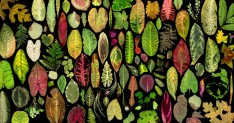
Wrought, by Anna Sigrithur & Joel Penner
Los Angeles Filmforum presents
Experimentations: Imag(in)ing Knowledge in Film, Program 13
Natural History in Experimental and Artist Animation
Sunday January 12, 2025, 7:00pm
At 2220 Arts + Archives, 2220 Beverly Blvd., Los Angeles CA 90057
Tickets: $15 general, $10 students/seniors, free for Filmforum members
$20 for both programs today
https://link.dice.fm/Qd0ea36f14f3
The program will be preceded by a panel at roughly 4:30 pm and complimentary dinner at roughly 5:30 pm! The panel will include Jane de Almeida, Lilly Husbands, Eames Demetrios, and Jheanelle Brown in person, and filmmakers to be announced on Zoom.
In-person: Curator Lilly Husbands
It is impossible to overestimate the influence of scientific knowledge on artists’ investigations of the world, and nowhere is this influence more apparent than in contemporary moving image artists’ responses to the climate crisis. In the context of mass extinction and global climate change, the science of ecology underlies key issues currently facing humanity, and, thus, ecological considerations are understandably pervasive in contemporary moving image artworks. This program presents a selection of works that engage with aspects of ecology in the form of natural history, understood in the way that ecologist and conservation biologist Tom Fleischner (2021: 17) defines it: as “a practice of intentional, focused attentiveness and receptivity to the more-than-human world” that “creates a forum for interaction with Others, encouraging compassion and respect, helping us rediscover passion for the world and each other.”
Curated by Lilly Husbands.
Lilly Husbands is a lecturer in Animation and Visual Culture at Middlesex University. Her research is broadly concerned with the legacy and evolution of experimental animation in the context of contemporary multimedia practice. She has published numerous book chapters and articles on experimental animation in journals such as Moving Image Review & Art Journal (MIRAJ), Frames Cinema Journal and Alphaville: Journal of Film and Screen Media. She is the co-editor of the book Experimental Animation: From Analogue to Digital (London: Routledge, 2019). She is an associate editor of Animation: An Interdisciplinary Journal.
Experimentations: Imag(in)ing Knowledge in Film is Filmforum’s expansive film series and upcoming publication that investigates the ways that experimental and scientific films produce and question the visualization of the world. Combining artist films utilizing scientific imagery, science and natural history films, and films of indigenous and traditional knowledge, the series examines how science, nature, and technology films shape our understanding of humans, nature, gender, knowledge, and progress. The multi-venue public screening series presents analog and digital time-based media incorporating diverse scientific and experimental film traditions from across the globe. The series will include eighteen screenings between September 2024 and February 2025, with films and digital works from 1874 to today from around the world, multiple guests, panels and wonderful collaborations that will reveal the possibilities and circumstances of cinema in this realm.
Experimentations: Imag(in)ing Knowledge in Film is among more than 70 exhibitions and programs presented as part of PST ART. Returning in September 2024 with its latest edition, PST ART: Art & Science Collide, this landmark regional event explores the intersections of art and science, both past and present. PST ART is presented by Getty. For more information about PST ART: Art & Science Collide, please visit: pst.art.
Major support for Experimentations: Imag(in)ing Knowledge in Film is provided by the Getty Foundation and The Andy Warhol Foundation for the Visual Arts. Additional Support from the Los Angeles County Board of Supervisors through the Los Angeles County Department of Arts & Culture, and the Department of Cultural Affairs, City of Los Angeles.
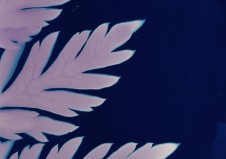
Athyrium filix-femina
Athyrium filix-femina
Kelly Egan, Canada, 2016, 35mm transferred to digital, color, sound, 4:19
ATHYRIUM FILIX-FEMINA , the 2nd "quilt film" paying homage to pioneering female artists, was created using Atkins' original cyanotype recipe, coating 35mm film, and exposing each filmstrip to sun. The images are a combination of botanical photograms like Atkins’ images and found footage that tells the story of a young girl tormented by a gang of bullies that, weaved together, produce a feminist narrative that questions malecentrism within the history of the photographic arts and sciences.
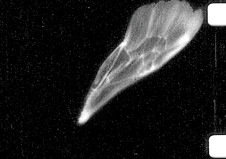
Not (A) Part
Not (A) Part
Vicky Smith, UK, 2019, 16mm transferred to digital, color/b&w, sound, 6:00
NOT (A) PART was conceived in relation to both the rapid decline of flying insects and the high recurrence of animation, handmade or contact film that works with the subject and/or material of flying insects. Numerous dead bees found on walks were positioned directly onto negative film and contact printed. Occupying approximately 24 frames they run at a rate of 1 bee per second. The length of the film is determined by how many specimens are found over a specified period of time.
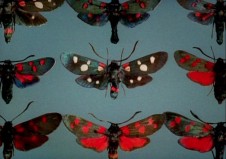
While Darwin Sleeps
While Darwin Sleeps
Paul Bush, UK, 2004, 35mm transferred to digital, color, sound, 4:52
More than three thousand insects appear in this film each for a single frame. As the colours glow and change across their bodies and wings it seems that the genetic programme of millions of years is taking place in a few minutes. It is a rampant creation that seems to defy the explanations of evolutionists and fundamentalists. It is like a mescaline vision dreamt by Charles Darwin.
The film is inspired by the insect collection of Walter Linsenmaier in the natural history museum of Luzern. As each insect follows the other, frame by frame, they appear to unfurl their antennae, scuttle along, flap their wings as if trying to escape the pinions which attach them forever in their display cases. Just for a moment the eye is tricked into believing that these dead creatures still live . . .
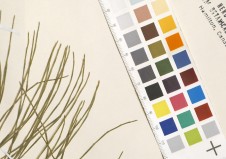
Herbaria x Pelicula: Field Notes
Herbaria x Pelicula: Field Notes
Derek Jenkins, Canada, 2021, 16mm, color, 11:01
This “Field Portfolio” is a single channel version of the multichannel installation “Herbaria × pelicula.” A consideration of collection as both archive and act, “Herbaria × pelicula” examines the work that takes place at the HAM Herbarium of Royal Botanical Gardens (Canada), located in Burlington ON along the edges of Cootes Paradise wetland, traditional territory of the Mississauga and Haudenosaunee peoples. The herbarium collection, which houses over 60,000 holdings, comprises specimens from around the world but is made up primarily of local vascular plant types gathered by the scientific community and educated hobbyists. Combining documentary footage of the herbarium space, code-generated database animations of digitized specimen sheets, and images of plantlife processed in plant material, the film work positions the specific labour of botanical gathering and collection as an image-making practice in addition to a mode of knowledge production.
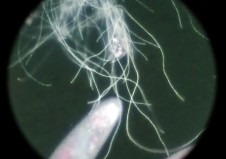
Sila, Silap Inua, Silla
Sila, Silap Inua, Silla
Alisi Telengut, Canada, 2020, digital, color, sound, 2:39
Associated with the exhibition "Critical Zones" at ZKM in Karlsruhe, the work explores the ideas of "sila" and "critical zones" and was created as part an excursion from Filmuniversitaet Babelsberg to ZKM.
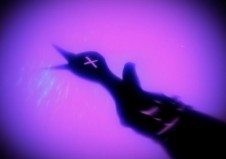
Somnium Lapidum
Somnium Lapidum
Emily Pelstring, Canada, 2016, 16mm to digital, color, sound, 3:19
This stop-motion 16mm film offers an audiovisual meditation on the material animation of stones. The concept is inspired by Camillo Leonardi's "Speculum Lapidum", published in 1533, which describes the magical healing virtues of a variety of stones, categorized by colour. The character-based animated vignettes are inspired by the woodcuts in “De Hortus Sanitatis”, a natural history encyclopedia published in 1485, which details various methods of harnessing the power of gems. It was believed at the time that a given gem's powers could be absorbed through focused viewing. Proposing an analogy between this belief and attraction to cinema, this film offers audiences an opportunity to absorb the depicted stones’ energies by viewing their images. The title, Somnium Lapidum, or Dream Stones, is a reference to the imaginative content of the “Speculum Lapidum” and the dreamlike experience of cinematic viewership.
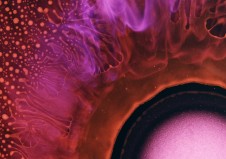
Chemical Somnia
Chemical Somnia
(Scott Portingale, Canada, 2022, digital, color, sound, 3:47)
A cross-continental collaboration between filmmaker Scott Portingale and composer Gorkem Sen. The film transports the viewer into chemical dimensions, exploring phase transition, fluid dynamics, and chemical reactions. Timelapse and high-speed photography were used on a macro scale to capture these elemental relationships in less than a square inch area on a petri dish. Uniquely resounding original music preformed by Gorkem Sen on an instrument he invented, the yaybahar.
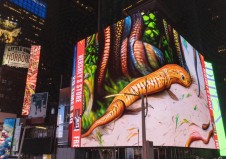
Critically Extant
Critically Extant
Sofia Crespo, 2022, digital, color, sound, 9:00
Critically Extant is a project that explores just how little we know about the natural world by testing the limits of the data openly available to us in our digital lives. To achieve this, AI algorithms were trained on millions of open source images of nature and some ten thousand species. The resulting models were then used to generate visual representations of species that are critically endangered, yet have little or no online presence specially on social media The goal of this was to not only trace the edges of our knowledge, but to also explore how we can create feedback loops in the digital that can be positive for the natural world.
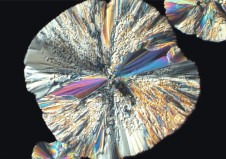
Lattice
Lattice
(Maria Constanza Ferreira, 2017, digital, color, sound, 2:41)
Iridescent waves, geometrical gardens, and spiraling sand dunes found in the landscapes of a crystal’s microscopic structure.
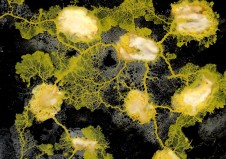
Wrought - slime mold
Wrought
Anna Sigrithur & Joel Penner, Canada, 2022, digital, color, sound, 22:24
A visual exploration of decay begs questions about our relationships with other species.
Wrought begins with that universal moment of disappointment: despite all best efforts, our food has gone bad. But instead of turning away in disgust, Wrought zooms in with curiosity through timelapse photography.
Wrought explores how we construct categories for the world. It examines the categories of spoil, ferment, compost and rot, coaxing audiences to decompose the binary of human and non-human. We are forged from the relationships that transgress such binaries; we are all, indeed, wrought.
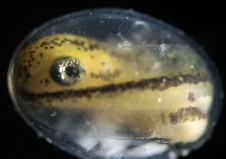
Becoming
Becoming
Jan van Ijken, Netherlands, 2018, digital, sound, color, 6:14
BECOMING is a short film about the miraculous genesis of animal life. In great microscopic detail, we see the 'making of' an Alpine Newt in its transparant egg from the first cell division to hatching. A single cell is transformed into a complete, complex living organism with a beating heart and running bloodstream.
The first stages of embryonic development are roughly the same for all animals, including humans. In the film, we can observe a universal process which normally is invisible: the very beginning of an animal's life.
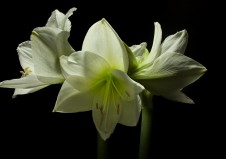
Spring
Spring
Jamie Scott, USA, 2017, digital, color, sound, 4:09
Spring is Jamie Scott’s second seasonal time-lapse film and the first collaboration with composer Jim Perkins. It is the culmination of 3 years of experimentation. The film challenges the status quo by shooting timelapse flowers with a moving camera which enabled him to create a seamless transition from scene to scene. The visuals and music were created in parallel and therefore sync together seamlessly.
